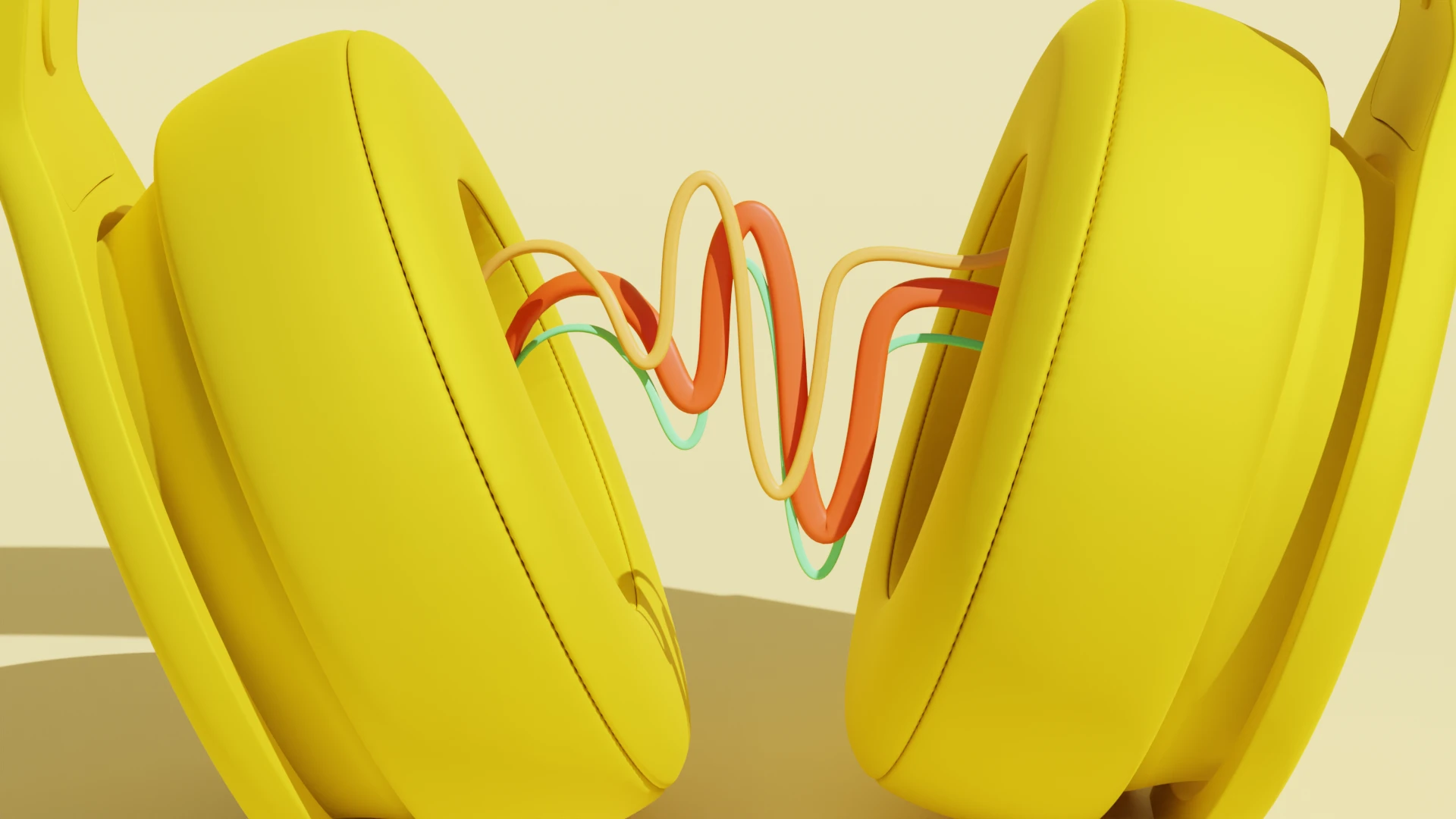What type of content do you primarily create?




Forget the pricey studio bookings. Today, high-quality audio capture is a click away.
Whether you like to produce podcasts, record music, or stream gaming sessions, you’ll need audio recording software to make it happen. The best part: Whatever your platform—Windows, Android, macOS, or Linux—there's software designed for it.
Not sure which to choose? This guide shares eight of the best audio recording software platforms for any device and budget, ranked by the best features on offer.
| Audio recording software | Best for |
|---|---|
| Descript | All-in-one audio recording and editing |
| Audacity | Multi-platform, budget-friendly editing |
| Adobe Audition | Professional audio recording and editing |
| GarageBand | Musicians on Mac devices |
| Audio Hijack | Live audio and VoIP recording |
| Reaper | Professional sound engineers |
| Ableton Live | Recording live performances |
| FL Studio | Producers and DJs |
8 best audio recording software for creators
Audio recording software lets you capture and shape sound for just about any creative project—like music, podcasts, or voiceovers. Think of it as your audio notepad and editing suite rolled into one, so you can record and fine-tune everything in the same place.

8 best audio recording software picks for creators
If you’re a creator who’s in the market for new audio recording software, here are the best options:
- Descript
- Audacity
- Adobe Audition
- GarageBand
- Audio Hijack
- Reaper
- Ableton Live
- FL Studio
1. Descript
Best for: Creators looking for an all-in-one audio recording and editing solution.
Descript is a versatile audio recording platform for modern creators. Record just yourself, your screen, or even a remote podcast guest—all in one place.
Once you’re done, Descript automatically transcribes your recording. Then you can tidy it up just like you’d edit text: cut, rearrange, or add effects—no need to dive into complex timelines. It’s a massive time saver and easy to pick up.
Best features:
- Filler word removal to banish”ums” and “uhs” from your audio recording
- Remote recording tools to interview people online (perfect for podcasters!)
- AI Voices feature to fix mistakes in the recording with a clone of your voice
- Collaborative audio and video editing tools for working with teams
- Studio Sound to remove background noise and create professional-grade audio
Pros of Descript:
- Intuitive, doc-style editing
- Automated audio transcription
- User-friendly dashboard
- Built for collaborative audio recording
- Rated 4.5 out of 5 stars on G2
Cons of Descript:
- No mobile app available—just browser, Mac, and Windows
- Limited transcription hours on free plans
Pricing: Descript offers a free plan that includes access to all premium features. For more hours of audio recording and transcription, paid plans start at $12 per user per month.
2. Audacity
Best for: Multi-platform users editing a variety of audio types on a limited budget.

Audacity is a free, open-source digital audio workstation (DAW) that supports a variety of audio types. It’s a popular choice for podcasters, voiceover artists, and anyone interested in audio recording or editing that’s running on a budget and doesn’t mind using third-party plugins for more advanced features.
Audacity is designed to be easy to use and supports all major operating systems including Windows, MacOS, and Linux.
Best features:
- Multitrack editing to manage and mix multiple audio clips together
- Ability to record audio with a microphone, MIDI device, or audio interface
- Royalty-free sound effects in the Muse Hub
- Normalize feature to make different tracks sound consistent
Pros of Audacity:
- Free software makes it accessible to anyone
- Lots of editing options for dialogue and music
- Simple user interface
- Compatible with several plugins and integrations
Cons of Audacity:
- No mobile version
- No option to create a transcript
- User interface looks dated
- While popular, not the industry standard
Pricing: Audacity is a free, open-source audio recording tool.
3. Adobe Audition
Best for: Professional audio editing and recording.

Adobe Audition is a professional audio workstation that allows you to create, mix, and design sound effects. It’s designed for professionals who need more advanced features from their recording platform.
Adobe Audition is not just limited to audio editing; it’s also great for mixing audio for video post-production (with a seamless integration with Premiere Pro), making it a versatile choice for professionals in different creative fields. While it doesn’t have the most user-friendly interface, Adobe Audition is full of powerful tools for professional use.
Best features:
- Automatic loudness correction
- Record, edit, and mix audio for video with the Premiere Pro integration
- Multitrack editing to edit multiple audio files in a single project
- Wide range of audio effects to add personality to your recording
Pros of Adobe Audition:
- Wide support for different audio formats and third-party plugins
- Part of the Adobe Creative Cloud suite of products
Cons of Adobe Audition:
- No MIDI input to record audio with this type of device
- The cost could be a barrier for hobbyists or individuals on a budget
- Requires a learning curve to use it at its full potential, especially beginner audio editors
Pricing: Adobe Audition is available for $22.99 per month on its own or with the full suite of Creative Cloud apps for $59.99 per month. The audio recording software also has a free trial.
4. GarageBand
Best for: Musicians who want to record audio on a Mac device.

GarageBand offers a straightforward and intuitive dashboard that makes audio editing a simple process. It’s among the best free audio recording software for creators who want to layer interviews, add background music, and use sound effects for a rich auditory experience.
This audio recording software comes with a sound library filled with bundled content, giving you a wide range of options to enhance your audio quality. The support for third-party plugins means you can extend its capabilities even further if needed.
Best features:
- Metronome feature to keep you on track as you record
- Record physical musical instruments by connecting them to your Mac
- Record software instruments like virtual pianos, guitars, and keyboards
- Studio-quality sound recording
Pros of GarageBand:
- Streamlined, professional dashboard
- Supports up to 255 audio tracks
- Compatible with third-party plugins
- Provides free lessons for beginners
- iPhone and iPad compatibility
Cons of GarageBand:
- Not available for Windows users
- No mixing console view
- Not the best for professional-grade sound editing
Pricing: GarageBand is free to use.
5. Audio Hijack by Rogue Amoeba
Best for: Live audio recordings and editing VoIP conversations.

Audio Hijack is a professional-grade recording software designed for MacOS users that lets you capture audio from literally any website or application on your Mac.
Whether you're browsing through an inspiring TED talk you want to sample for your next podcast episode or you want to save webinar audio for reference later, Audio Hijack is right there with you, ready to record.
Best features:
- Livestream recording to save your audio post-stream
- Magic Boost and volume blocks to balance audio levels
- Powerful podcast recording options with a simple compressor block
- Record audio from virtually any application on your Mac
Pros of Audio Hijack:
- Modern drag-and-drop interface
- Ability to record web streams for offline listening
- Variety of audio capture options including application, device, and system audio
Cons of Audio Hijack:
- Only available on Mac devices
- Steep-ish learning curve for beginners
Pricing: Single user license costs $64.
6. Reaper
Best for: Professional sound engineers who want to record and mix audio.

Reaper is a digital audio workstation designed for professional sound engineers who want to mix audio in the same platform they use to record it.
Reaper stands out in its compatibility with Virtual Studio Technology (VST) plugins. If you use plugins on your audio, you can add all kinds of audio effects to your sonic canvas in real-time. Whether you're creating an ethereal soundscape, dialing in the perfect guitar tone, or removing plosives and breath sounds from your narration, plugins open up your creative possibilities.
Because of its advanced features, Reaper does have a steep learning curve for new creators. But if you’re willing to learn the platform and pick up a new skill, it’s a good option.
Best features:
- Record audio in the same dashboard you use to edit
- Studio quality sound for any audio recording
- Mixer view to help you edit multiple tracks simultaneously
Pros of Reaper:
- Windows and Mac apps available
- Extremely customizable to design the DAW you want
Cons of Reaper:
- The interface can be hard to navigate
- No option to record audio on mobile
- Limited to audio recording (no video)
Pricing: If you’re recording audio for personal use, you’ll qualify for Reaper’s $60 license. If you’re recording audio for a business that earns over $20,000 per year, you’ll need to get its $225 license.
7. Ableton Live
Best for: Musicians who want to record live performances.

Ableton Live is a great audio recording software for music creators. It offers a range of sound effects, virtual instruments, and creative features for music mixing. Whether you're tucked away in your studio or out there on stage, Ableton Live adapts seamlessly.
You can also connect any MIDI controller via Bluetooth or USB for another way to create. Albeton also lets you craft your own unique sound presets and templates, store them, and revisit them anytime. This means you can build a personal library of sounds and effects, tailor-made for your style.
Best features:
- Record acoustic and MIDI instruments in one dashboard
- Real-time tempo and timing adjustments with warping
- Suite of built-in instruments and effects
- Linked track editing to make bulk changes to multiple tracks at once
Pros of Ableton Live:
- Designed to record live audio
- Available for macOS and Windows
- Enables seamless transition between studio production and live performance
- Strong community and educational resources to learn more about audio recording
Cons of Ableton Live:
- No mobile app available
- The pricing is steep compared to other audio recording tools on the market
Pricing: Ableton’s most basic plan starts at $99 and includes 16 audio tracks. For unlimited tracks and advanced features, plans start at $439. There are payment plans available.
8. FL Studio
Best for: Music producers, composers, and DJs that need a versatile audio editor for better sound quality.

FL Studio is a comprehensive music recording and audio editing software that caters to seasoned music creators. It comes with the array of instruments, effects, and professional editing features you’d expect from software reportedly used by the world’s top DJs and producers.
With its long list of plugins, synths, and effects, it offers an expansive dashboard built for musical exploration as well as the occasional side project like podcast audio editing. Its lifetime of free updates is a great way for users to always have access to the newest features and improvements.
Best features:
- Range of plugins to apply audio effects like delay and reverb
- FL Cloud, its sister software, helps you master audio production
- Online forum of sound engineers who share their best tips for editing and recording audio
Pros of FL Studio:
- Lifetime free updates keep the software current
- Compatible with a wide array of plugins
- Built for creators who want to edit beyond the basics
Cons of FL Studio:
- Some users may find the software to be resource-intensive on their systems
- Rated below average for ease of setup
Pricing: FL Studio’s cheapest plan doesn’t include audio recording. This feature is only included in its most popular plan, which is a one-off fee of $149. All plans come with free lifetime updates.
Features to look for in audio recording software
Multitrack recording and editing
Multitrack recording lets you capture multiple audio channels, or “tracks,” independently. It gives you the freedom to edit each track without affecting the others. This could mean recording yourself on one track and a guest on another if you’re recording a podcast.

Let's say you're making your first podcast episode. You can record your narration, guest interviews, and background music on separate tracks, so you can adjust the volume, tone, and clarity of each element individually.
If your guest's volume is slightly lower than yours, you can boost it without affecting the rest of the episode. What might have been a boring podcast becomes a dynamic, professional audio production with this granular control.
Real-time audio effects and processing
With this functionality, you can apply sound effects and enhancements while recording or playing back audio. The benefit? You don't have to wait until the recording is done to hear how EQ and compression, noise reduction, or reverb impacts the sound.
It's like trying on clothes in a fitting room—you get to see (or hear) how your choice fits, and decide whether or not to keep it.
Non-destructive editing and automation
Non-destructive editing refers to editing audio without permanently altering it. You don't have to lose the original recording if you cut, fade, or apply effects.
With this feature, you can revert to an earlier version or tweak an edit without losing any previous work. It's like having an unlimited undo button so you can experiment without risking your original work.
High-quality audio file formats and export options
The ability to export in high-quality audio formats cannot be overstated. In music production, film production, and broadcasting, high fidelity is critical. These formats ensure that the audio is reproduced as accurately as possible, which is crucial for mixing, mastering, and post-production.
Formats like WAV, FLAC, and AIFF preserve the full quality of the audio, ensuring no details are lost during digital encoding. They offer greater bit depth (like 24-bit) and higher sampling rates (such as 192kHz). The result is richer, more detailed sound, which captures nuances and subtleties you wouldn't find in lower quality formats.

Different platforms and applications require different formats. For example, a music producer might need WAV files for studio work but also MP3 versions for online distribution. Having a range of export options means one software, like Descript, can cater to all these needs.
Audio recording software FAQs
What is good audio recording software?
We recommend reviewing our top eight picks for audio recording software, since each tool excels in different areas. Our list includes:
- Descript
- Audacity
- Adobe Audition
- GarageBand
- Audio Hijack
- Reaper
- Ableton Live
- FL Studio
They each offer unique features for podcasters, musicians, or general content creators. Consider your budget, hardware, and goals when choosing the right software.
- Descript
- GarageBand
- FL Studio
- Audacity
- Adobe Audition
What is the best software to record and edit audio?
- Descript: Great for podcasting and collaborative editing
- Audacity: Free and multi-platform with solid editing tools
- Adobe Audition: Advanced features for professionals and seamless video integration
- GarageBand: Simple recording and editing for Mac-based musicians
- Audio Hijack: Flexible live audio capture on Mac
- Reaper: Customizable DAW for detailed audio mixing
- Ableton Live: Ideal for music creators who perform live sets
- FL Studio: Popular among DJs and producers for pattern-based composition
The right choice depends on your workflow, OS, and project goals. If you need an all-in-one platform with text-based editing, Descript is a good pick. For a pro-level workflow, consider Adobe Audition or Reaper.
| Software | Compatible with | Typical pricing |
|---|---|---|
| Descript | Mac, Windows, Browser | Free plan available; paid plans from $12/month |
| Audacity | Windows, Mac, Linux | Free |
| Adobe Audition | Windows, Mac | Monthly subscription |
| GarageBand | Mac | Free |
| Audio Hijack | Mac | One-time $64 |
| Reaper | Windows, Mac | $60 personal/small business license |
| Ableton Live | Windows, Mac | Paid tiers from $99 |
| FL Studio | Windows, Mac | One-time $149+ (for audio recording) |
Creators often pick these platforms depending on their operating system, recording needs, and budget.
What is the best software to record and edit audio?
How do I record audio from my computer?
You can record audio directly from your computer in a few steps:
- Choose a recording tool that supports system audio capture, like Descript’s Recorder or another software that can capture computer sound.
- Enable “computer audio” or “same as system” in your recording settings so the software can capture what you hear.
- Press “record,” play your audio source (like a browser or media player), and let the software capture it in real time.
- When you’re done, stop the recording. You can then edit or export the audio file as needed.
If you want to refine the audio, use built-in features (such as Descript’s Studio Sound) to reduce noise and enhance clarity.
What is the best free audio recording software for PC?
Several free options work well on Windows PCs. Many creators start with Audacity because it supports multi-track recording and editing at no cost. The free plan of Descript is another option if you want quick transcription and seamless text-based edits. For Mac users with a PC backup, GarageBand is a free choice if they switch to or use Apple hardware. Ultimately, each tool’s core features are sufficient for beginners—pick the one that fits your workflow.
- Best for creators and podcasters: Descript
- Best for musicians on Mac: GarageBand
- Best for customization features: Audacity
- Best for live recording: Audio Hijack
- Best for professional sound engineers: Reaper





























%201.svg)






















